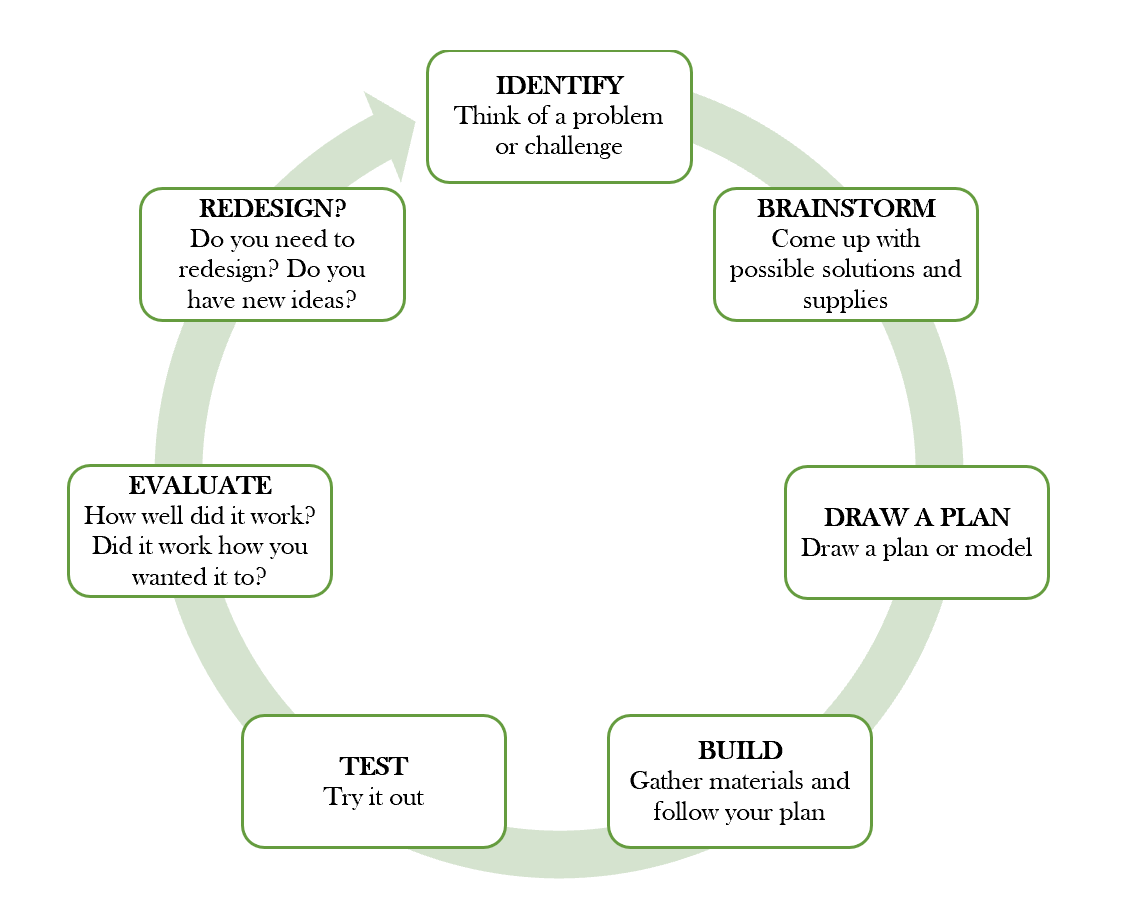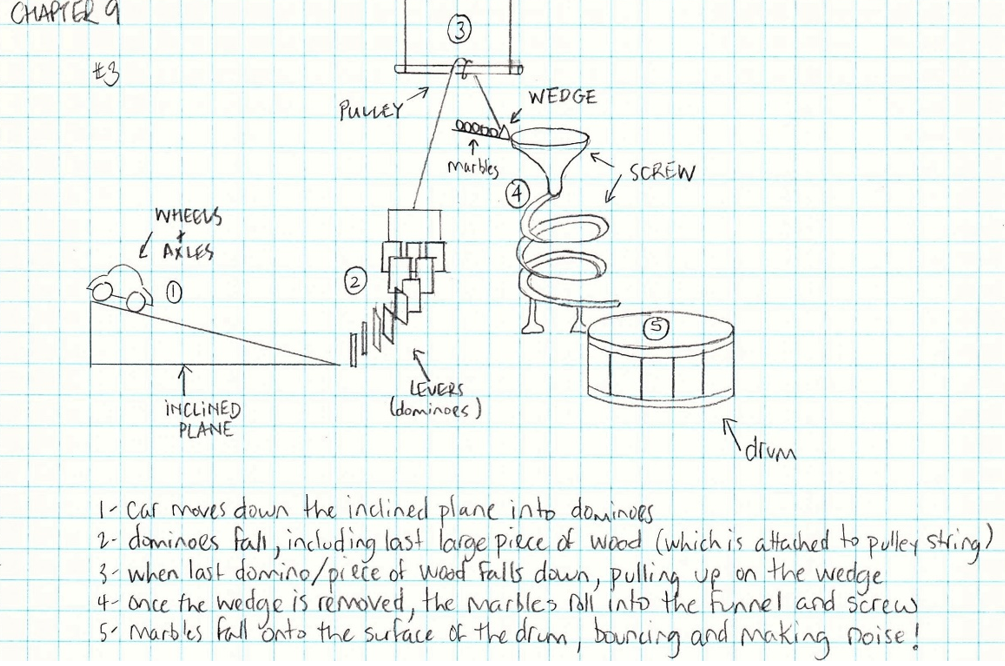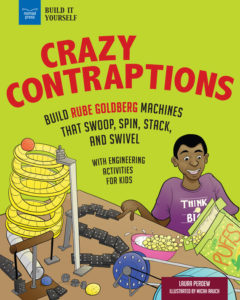“Crazy Contraptions: Build Rube Goldberg Machines that Swoop, Spin, Stack, and Swivel”
Collect your catapults, toy cars, pulleys, ramps, marbles, balls, and dominoes. You’ll probably also want string, tape, hot glue, cardboard, TP rolls, and miscellaneous recycling. Now, what should you do with this odd assortment of materials? Build Rube Goldberg machines, of course!
Rube Goldberg machines are crazy contraptions that perform very simple tasks through an exceedingly complicated and usually humorous chain reaction. The man behind the machines was Rube Goldberg. He was an engineer turned cartoonist in the mid-1900s. He is famous for his cartoons that featured the crazy contraptions he invented (check out the image gallery at https://www.rubegoldberg.com/image-gallery-licensing/). His “inventions” include a self-operating napkin, a painless tooth extractor, and even an elaborate method to keep the baby covered at night. People loved Goldberg’s cartoons and couldn’t wait to see what he would come up with next. Yet even though people loved his inventions and Goldberg was an engineer, he never built a single one of his contraptions.
Instead, the idea to build crazy contraptions was initiated by college students in 1949. Since that time, building contraptions has become wildly popular. Rube Goldberg, Inc. even holds an annual Rube Goldberg Machine Contest which challenges students to create their own crazy contraptions that perform a designated task (https://www.rubegoldberg.com/learn-about-the-contests/). Creating contraptions is also a great hands-on project in the classroom to teach basic physics concepts (energy, force, motion, and work) and to introduce the six simple machines to kids. And it’s FUN!
CRAZY CONTRAPTIONS: Build Rube Goldberg Machines that Swoop, Spin, Stack, and Swivel teaches all of these concepts. It also encourages contraption makers to use the engineering design process – brainstorming, planning, building, testing, evaluating, and redesigning (if necessary). The book starts out with easy challenges using one simple machine. As the book progresses, though, readers are challenged to build increasingly complex contraptions using more and more simple machines. Warning! This book does not include step-by-step instructions to build each contraption. Instead, it presents these challenges in a way that allows readers to use their own creativity and materials they may have on hand. So, go collect that odd assortment of material and start building!
Activity
Introduce students to Rube Goldberg contraptions by watching this music video by OK Go: https://www.youtube.com/watch?v=qybUFnY7Y8w or visiting the Rube Goldberg image gallery.
The challenge here is to have students create a crazy contraption that uses all six simple machines to bang on a drum using engineering design process:
Identify: The challenge, as stated above, is to build a crazy contraption that uses all six simple machines to bang on a drum.
Brainstorm: What materials will students use for each of the six simple machines in the contraption? Here are a few ideas…
Inclined plane – books, toy car tracks, piece of cardboard, piece of paper
Levers – dominoes, catapults, rulers, popsicle sticks, pencils
Wheels and axles – toy cars or trains, a homemade car, screwdriver
Pulleys – a pulley, empty thread or wire spools, pushpins
Wedges – make your own, popsicle sticks, string
Screws – jars and lids, marble runs, funnels, tubing
Don’t forget the drum and whatever will bang on it to make the noise!
Consider how all those parts might work together to create the contraption.
Draw a plan: Break out the graph paper, pencils, and rulers. When I wrote the book, this is what my design looked like:
Build: Put it all together! Hint – do the dominoes last!
Test: After building, adding, tweaking, taping, and creating, start the chain reaction.
Evaluate: More often than not, the first few tests of crazy contraptions fail. But that’s okay! The question to ask is, “Why?” This question and its answer help young engineers create contraptions that DO work.
Redesign: Using what your students know about why the contraption did or did not work, they may want to redesign it. Or, they may want to make it louder. Or add other noisemakers.
Crazy Contraptions: Build Rube Goldberg Machines That Swoop, Spin, Spack, and Swivel with Engineering Activities for Kids
Author: Laura Perdew
Illustrator: Micah Rauch
Published October 8th, 2019 by Nomad Press
About the Book:An exciting book about the chain reaction world of Rube Goldberg for middle schoolers, including 25 engineering design projects that get middle schoolers applying the laws of physics to their own inventions as they learn the scientific principles behind the actions and reactions they create.
Why use a simple hand motion to wipe your mouth when you can build a machine to do it for you? Toppling dominoes, rolling marbles, racing balloon cars, springing catapults, and whizzing zip-lines are all elements used to build Rube Goldberg machines in Crazy Contraptions: Build Machines that Swoop, Spin, Stack, and Swivel with Engineering Activities for Kids. The book introduces kids ages 9-12 (and beyond!) to the wacky machines designed by Goldberg, which were based on complicated chain reactions used to accomplish very simple, sometimes ridiculous, tasks.
-Through contraptions, the book discusses the basics of physics, including force, motion, and work. Each chapter introduces one of the six simple machines and how they can be used in Rube Goldberg contraptions–inclined planes, levers, wheels and axles, wedges, screws, and pulleys.
– Kids are challenged to design, build, and evaluate dozens of increasingly complex contraptions that do things like unscrew a lid, turn the page of a book, and pop a balloon.
– Projects use materials already in most homes–reimagining and repurposing everyday items, as well as mining the recycling!
– Contraption hints, essential questions, short sidebars, and links to online primary resources help readers learn the basics of force, work, motion, and simple machines, while exploring their creativity as they design and build their own crazy contraptions.
About the Build It Engineering set and Nomad Press
Crazy Contraptionsis part of a set of two Build It Engineering books that explore the engineering technology behind our daily lives. The other titles in this series isBots! Robotic Engineering with Makerspace Activities for Kids.
Nomad Press books in the Build It series integrate content with participation. Combining content with inquiry-based projects stimulates learning and makes it active and alive. Nomad’s unique approach simultaneously grounds kids in factual knowledge while allowing them the space to be curious, creative, and critical thinkers.
About the Author:Laura Perdew is an author, writing consultant, and former middle school teacher. She has written more than 15 books for the education market on a wide range of subjects, including the animal rights movement, the history of the toilet, eating local, and the Great Pacific Garbage Patch. She is a long-time member of the Society of Children’s Book Authors and Illustrators. Laura lives in Boulder, Colorado.
Thank you so much for this guest post–love the STREAM focus!




